What is the average rainfall for broomsedge bluestem to grow?
Silver Leaf Nightshade
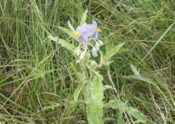
Silver Leaf Nightshade (Solanum elaeagnifolium Cav.) is an upright, usually prickly perennial in the nightshade family. It normally grows one to 3 feet alpine and reproduces by seed and creeping root stalks. Leaves take a silvery colour (hence the proper noun) with wavy margins and are lance shaped to narrowly oblong. Flowers are violet or bluish (sometimes white) with yellow centers. The fruits are round and xanthous and are present from May to October. The plant has poor forage value for livestock and wild animals and can be poisonous to… Read More than →
Weed of the Week: Johnsongrass
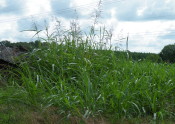
Weed of the Week: Johnsongrass (Sorghum halepense): Johnsongrass is a warm season perennial grass that is one of the nigh common and troublesome weeds in agronomics. It is normally found on roadsides, pastures and hay fields. It grows cock from 3 to vi anxiety. Johnsongrass spreads by seeds and rhizomes (underground stems). The seedhead is a large, open panicle oftentimes with a purplish tint. Johnsongrass leaves have a large white midrib and a polish, glossy appearance. Stems are smooth with no hairs. Select Herbicide Options: Outrider (for… Read More than →
Poultry Litter
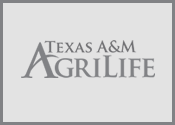
Poultry litter has get a mutual alternative source of plant nutrients in Central and East Texas. Especially as the poultry manufacture grows in parts of Central and Due east Texas. Broiler litter is a mixture of poultry manure, bedding, feathers, and spilled feed. The actual nutrient content of a manure sample varies. Nutrient concentration of broiler litter is variable due to age of bird, composition of the nutrition, how the manure is handled, and the number of batches of birds raised since the last house make clean out. The average… Read More →
Weed of the Week: Broomsedge Bluestem

Broomsedge Bluestem (Andropogon virginicus L.) is a warm flavor perennial grass establish throughout Central and E Texas. Broomsedge growth begins equally temperatures consistently stay above lx degrees F. It produces many seeds that are distributed by wind. It is a poor competitor, has poor nutritive value for livestock and low palatability. Broomsedge can chop-chop go the dominant species in over-grazed, low pH (< five.five), low fertility, eroded soils where desired vegetation will non thrive. Since this plant thrives on low pH and low fertility soils, soil testing is… Read More →
Weed Control For Newly Sprigged Bermudagrass
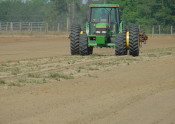
Weed Command for Newly Sprigged Bermudagrass… WEED Control FOR NEWLY SPRIGGED BERMUDAGRASS. "One of the many challenges producers face up when establishing a new stand of bermudagrass is initial weed pressure level. Prior to land preparation for establishment of sprigs, it is important to eradicate any unwanted vegetation." Vanessa Corriher-Olson Forage Extension Specialist Soil & Ingather Sciences Overton, TX vacorriher@ag.tamu.edu Texas A&1000 AgriLife Extension Service Texas A&Thou University Organization
Sprayer Calibration
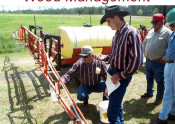
Sprayer Calibration is a critical step for a pesticide applicator in making sure the correct amount of pesticide is applied to the target site. Calibration is the process by which the corporeality of pesticide being applied per a unit of surface area is adamant. This step is nigh oftentimes skipped because nosotros go far a hurry, we calibrated it once a long time ago (surely nothing has changed) or we forget. By skipping sprayer calibration the applicator may be applying likewise much pesticide or not plenty pesticide. If too little… Read More than →
Weed of the Week: Sedges (Yellow Nutsedge, Majestic Nutsedge, Globe Flatsedge)
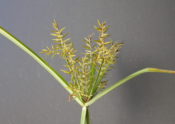
Yellow Nutsedge (Cyperus esculentus) is oft referred to as nutgrass or watergrass. Yellow nutsedge is a perennial found that reproduces primarily past minor underground tubers (called nutlets) that class at the end of cloak-and-dagger stems (rhizomes). A single plant can produce several hundred of these tubers throughout the summer. Yellow nutsedge can also spread past rhizomes. Yellow nutsedge can be identified past the triangular shape of its stem as can all sedges. You can experience the shape by rolling the stem in your fingertips. One method of control… Read More →
Native Grasses for Texas
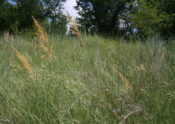
One may be surprised to learn that bermudagrass and bahiagrass are Not native to Texas much less to the U.s.. At that place are numerous species of grasses and forbs that tin exist utilized for forage throughout the state of Texas. Keep in listen as we select forages we need to exist mindful of our product organization goals, location (soil type and rainfall), and the nutrient needs of our livestock (and/or wild fauna). Many livestock producers are considering forage species and varieties that do not require as much fertilizer equally… Read More →
Suns Out, Fertilizer Out?

After a cold, dreary winter we get broken-hearted about our warm season perennial pastures and hay meadows. Nosotros start panicking about the winter weeds we encounter growing, the volunteer ryegrass nosotros encounter growing and we get-go making calls to our local fertilizer retailer. Detect more than information about dealing with volunteer ryegrass here and dealing with wintertime weeds here. Now, let's take a moment and talk about the RIGHT fourth dimension to fertilize our warm flavor pastures/hay meadows. First and foremost, soil test. If you have not done then… Read More →
Baleage: What is it and practise I need it?
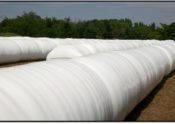
Baleage involves baling forage with l to 65 % moisture content, so wrapping the bales in plastic to create an air tight environment. This reduces the conditions risk producers commonly face while waiting for the forage to field cure and harvest. Harvesting the forage at higher wet levels allows for the forage to more readily retain its nutritive value and digestibility compared to conventional hay. Aerobic (free oxygen requiring) leaner consume the oxygen remaining inside the hay within a few hours. Under these conditions, anaerobic (non-free oxygen requiring) bacteria… Read More →
Source: https://foragefax.tamu.edu/page/4/
0 Response to "What is the average rainfall for broomsedge bluestem to grow?"
Post a Comment